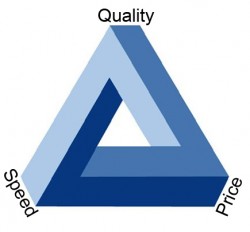As I have shown in the previous post (Tradeoffs Small Businesses Make Are Wrong) picking up “cheap”, “good” and then “fast” is wrong? I promised to elaborate on a better answer, so here goes.
If you have any kind significant small business experience – you probably already suspected that there is no right answer. At least there is no silver bullet. What you want to do is project a right image and get the best for your business. You wouldn’t buy a hot dog from a street vendor for any price if you don’t eat hot dogs or if you are not happy with cleanliness of the spot. In other words – you always go for quality first and you are willing the price if this price is justified. When you go to a fancy restaurant – you’re not questioning the portions, even though they are noticeably smaller than any of all-you-can-eat offerings. Why? Because of the quality!
If you are not doing the same for your business, you should. Or you should quit. Quality is, in most cases, the best competitive advantage you can come up with. Features will be duplicated. Prices will be brought down. But beating quality is a long and complicated road, so if you can offer a higher quality product from the start – you should. It works the other way too – you should ask for the highest quality you can buy for your money.
That means you should start buying before you even look at the first price offering. Think of how important the product or the service is for your business, what the impact, the benefit or justification would be to having this product or service. For example, if you want a new web site for your new product – think how big is the market you want to engage and if whole new web site along with it’s promotion is worth the return you will get.
Once you are done assessing the desired outcome, you should start shopping around. This way when you are in negotiations with service provider or sales person – you know exactly what you want and how much you are willing to spend. A lot of companies are willing to give you the most bang for your buck – as long as you know what bang you want. In many cases that is what we offer our clients – give us your budget and we will give you the best we can that those money can buy. So far this approach for clients worked better than anyone else. This way we know how much we are paid and client knows what to expect for that amount – and is happy with it.
To wrap it up – the so-called “right” answer to the problem of choice is to get the best quality for the money you are willing to spend. Each time you have that urge to say “I want the cheapest thing possible” always think that some people throw food into garbage and that food is the cheapest you can find. Would you eat it? I’m sure you won’t.
 The trade-offs that small businesses are making are wrong. Well, most of them are. Look at the picture on the left and it will get obvious that you can’t just tweak one of the parameters without compromising other two.
The trade-offs that small businesses are making are wrong. Well, most of them are. Look at the picture on the left and it will get obvious that you can’t just tweak one of the parameters without compromising other two.